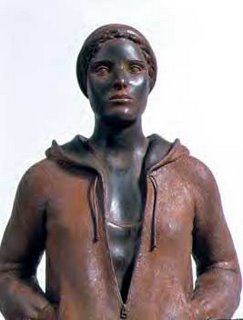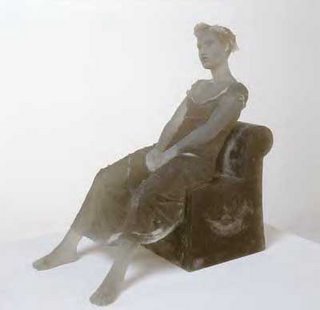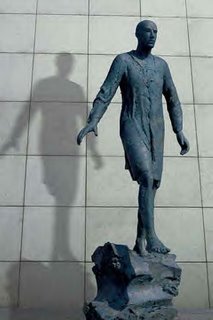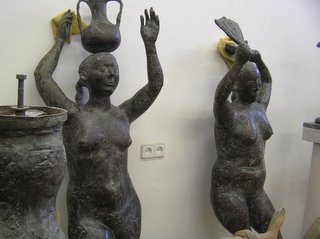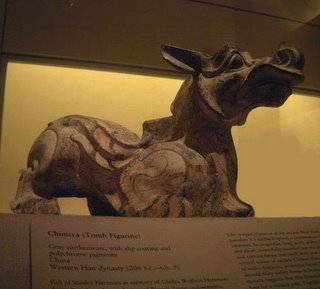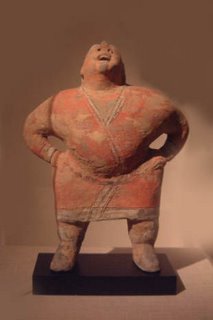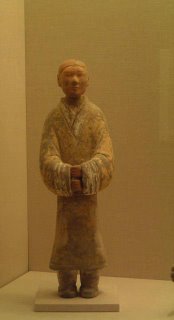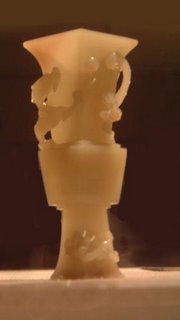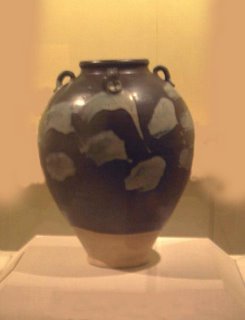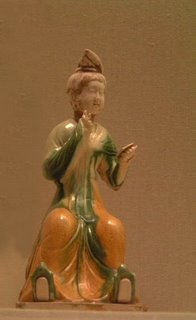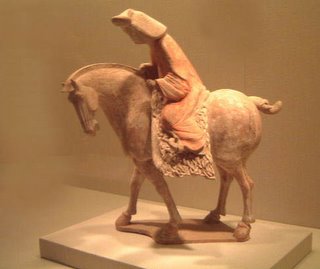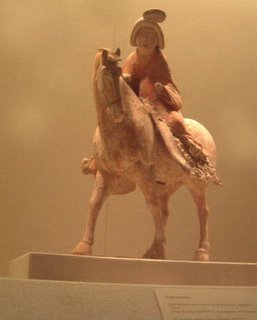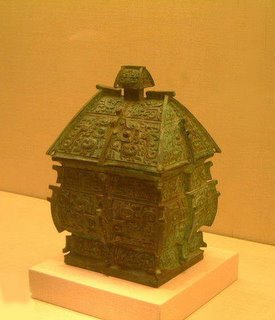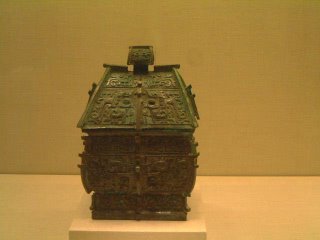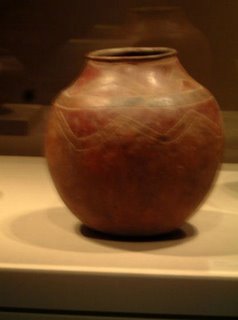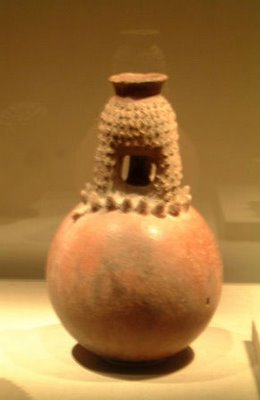The Art Institute (and other major museums) may never have this kind of exhibit in my lifetime -- but sculptors can always pay to promote themselves in magazines --
so here's an impromptu exhibit culled from the above publication -- and juried by
available funds.
Warning: I'm going to be pretty negative about all these pieces -- as I think they deserve the dreaded word, "kitch" which the dominant American art theory of 50 years ago assigned to all representational work.
But now that we've enjoyed 50 years of the pseudo-intellectual nihilism that replaced it, maybe we can begin to sort figure sculpture into the Good, the Bad, and the Ugly.

Frederick Hart: A much-praised - though weak -- entry in the great tradition of spiritural figures -- again relying on the surface rather than the mass - a facial expression of profundity, rather than profundity as an inner quality --- and the surrounding space wrapping the figure like paper around a filet of fish, rather than as an important space giving play to an important figure. It feels like "make-believe " -- rather than "I believe" -- and what could be worse for a national cathedral ?
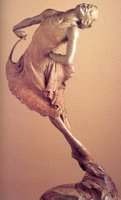
MacDonald: mistakes the expression of a face/body with the expression
of a sculpture - a smiling face does not make a smiling sculpture -- a twisting, elegant, wispy pose does not make a twisting, elegant sculpture This is how an
illustrator thinks-- and it's designed like graphic illustration, based on
an arrangement of contours rather than mass - the feeling for which is consistantly defeated:- by the wispy string of the dress; by the fragile connection of the off-balance foot to the base; by the head broken-up by the grimace. So it has the feeling of forced jocularity -- forced lightheartedness -- and what could be more unhappy ?

Danielle Anjou "The Titans": This is the most conservative piece in the show. It wants to be a piece of 19th C. Beaux arts garden sculpture --- which I suppose it is -- even if it's below the quality of the mediocre work from that era. An attempt is made at composition - but design never overcomes anatomy -- a tendon is still a tendon, nota measured stroke within a symphony of forms and spaces. So every part feels small and studied -- not rapturous, befitting the pagan gods to whom it is dedicated.
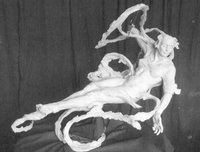
Snowden: In her full-page ad, M.L. Snowden claims the artistic legacy of Rodin through Robert Eberhard and her father, George H. Snowden -- but I think the legacy has come through Camille Claudel instead, that poor woman who was not strong enough to control the Rodin-like power with which she tried to work. This piece is a corpse-enshrouded nightmare -- appropriately titled "Caldera" (the collapse of a volcanic cone) This is the tension-lost collapse of energy -- and it belongs in a haunted house.

Shray: In response to early cubist sculptors like Lipchitz, American sculpture went through a highly stylized period in the forties and fifties -- which I don't think ever was that successful. The problem is that sculpture does not get any better or easier by removing the complex surface details -- it's just becomes quick -- too quick -- to make. This piece illustrates a gesture -- but nothing more. Shapes are either ballooned or pinched - which makes the piece feel as slick, empty, cold, and facile as romance in a soft-porn film.
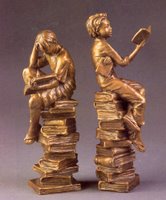
Gary Lee Price: There's no point in criticizing anything in this genre of cutesy figures of children. It's the love of smallness in every way -- smallness of spirit, ambition, decision, -- a longing for a world that is as soft, comfortable, and shapeless as a warm blanket. The ad does not list the size of these pieces -- but the smaller the better.
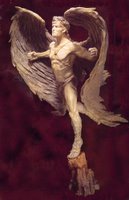
Gregory Beck "Edge of Faith" : When a dramatic gesture meets a weak form, the result is pathetic -- even if that's exactly how some people feel about their personal "edge of faith" -- people who might appreciate an artist who expresses that desparate pathos and brokeness. Is it too cruel to say that this presentation of bombastic, televangelistic self-delusion is comical ?
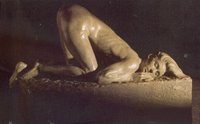

Bruce Wolfe: Why are we looking at these women ? What are they doing ?-- other
than posing for a sculptor -- who arranges their parts in an orderly, business-like fashion - each major anatomical feature handled with care and aplomb. Nothing dramatic -- nothing sexual -- even with the girl who has her booty up in the air. What's she doing ? Did the model fall asleep from boredom ? And yet -- there is a feeling of volume -- which distinguishes it from the others.
So I guess this exhibit is pretty much a failure -- evidence (if more evidence were needed) of the collapse of the Classical European sculpture tradition in the mid 20th century. It's as if Ms. Anjou never saw Carpeaux, Ms. Snowden never saw Rodin,
Shray never saw Lipschtiz, Hart never saw Rheims, Wolfe never saw Clodion,
Beck never saw a Kore. Overall, there's the problem of energy: it's all centrifugal -- spinning outward from the surface, without also pulling inward toward the mass -- so whatever gets expressed feels superficial, insincere -- and a bit destructive -- like modern, consumerist/capitalist civilization spinning out of control. There's the feeling that once the composition is set, and the details and gestures are in place , then the story is told , and it's time to move on. That is to say -- the ambition here is for illustration, not contemplation.
On the one hand, I wouldn't blame the sculptors for this. They're being business professionals in the sense of meeting the needs of a specific market --and a lot more people want to see a cute little child done to look cute and little -- rather than to look profound or timeless (as a Medieval sculptor might show the Christ child). But on the other hand -- they're following a culture, not leading it -- and isn't that the job of everyone (in every kind of work) who is capable of doing it ?
And -- as noted above -- there is no place where the European tradition of classical/natural sculpture can be assembled for comparison and judgement since our art museums are still in the final throes of terminal nihilism. But eventually -- that will change.
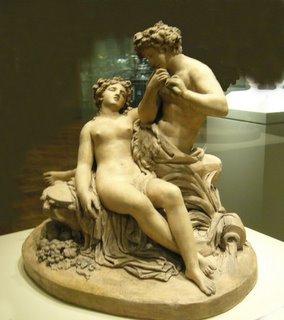

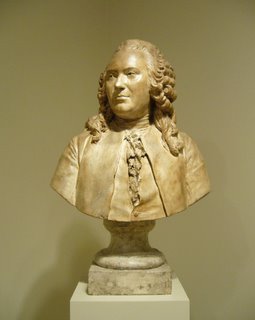 Why is Houdon in a room of "decorative arts"? Why is
Why is Houdon in a room of "decorative arts"? Why is
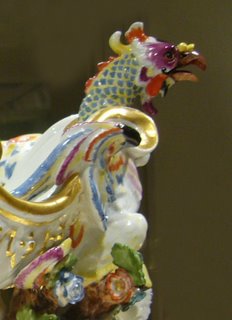 Here's my favorite detail of the above -- something about those colors --- I feel like I want to take a spoon and start eating it.
Here's my favorite detail of the above -- something about those colors --- I feel like I want to take a spoon and start eating it.


